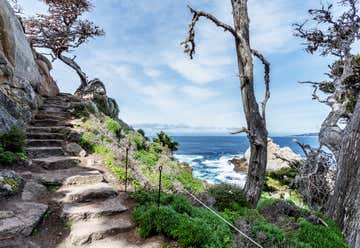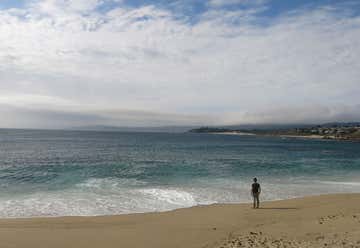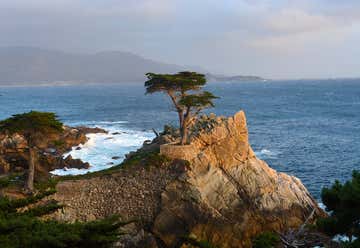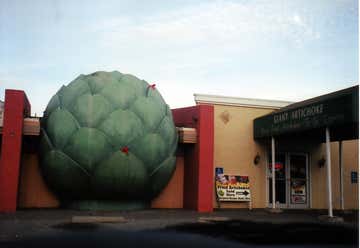48444 Victoria Lane, Oakhurst, United States
This trip is brought to you by our friends at 76®!
The stretch of Highway 1 that hugs Monterey Bay just might be the most memorable drive along the California coast, and we don't say that lightly. But there's a whole lot of greatness jam-packed into this 76-mile route; fairy-tale towns perched on the seaside, hidden coves sprinkled with wildflowers, retro boardwalks complete with carnival kitsch, and, of course, plenty of incredible beaches for swimming and surfing. If you can only do one small portion of Highway 1, trust us... this is the route you're gonna want to take.
Located in the northern portion of Big Sur, Point Lobos State Reserve has been called the "gem" of the California parks system. The rocky cliffs that form the point's headland give way to rolling patches of forests, canyons, and wildflowers on one side, and the Pacific on the other. You can swim, scuba dive, drive, hike, and kayak around the reserve, which protects an incredibly diverse ecosystem of plant and wildlife, such as harbor seals, sea lions, elephant seals, orcas, sea otters, gray foxes, coyotes, and Monarch butterflies. China Cove is a famous pocket beach that's worth visiting, and tourists should also check out the Whaler's Cabin, which displays old diving equipment, whale bones, and a ton of artifacts pertaining to Japanese and Chinese history.
Where the Carmel River meets the Pacific comprises a unique lagoon known as Carmel River State Beach. It's a popular habitat for migratory birds such as great blue herons, brown pelicans, woodpeckers, and more. The beach is particularly popular with kayakers, scuba divers, and birdwatchers. Kayakers especially like the waters below Point Lobos, while scuba divers typically congregate off Monastery Beach. And of course, the unique habitat attracts a number of different bird species, both migratory and permanent. Because of strong tides, swimming and surfing is considered dangerous. Beachgoers might also notice a giant cross. This is to commemorate Spanish explorers who landed on the beach in the 17th century.
Cruise up to the storybook village of Carmel-by-the-Sea and grab tea at The Tuck Box. Try the waffles or eggs Benedict from the breakfast menu, a sandwich or English pie for lunch, or a plate of their famed scones (served with preserves), and a cuppa for afternoon tea. From the decor to the recipes, this special place has remained virtually unchanged since the 1940s. In fact, the Tuck Box is the only commercial property designed by Hugh Comstock, who designed nearly two-dozen homes inspired by fairy tales in the town. Take a stroll around Carmel-by-the-Sea and see if you can spot some of the homes before hitting the road again.
The Lone Cypress is one of Big Sur's most iconic views. It's located along the famed 17 Mile Drive in Pebble Beach. The route connects two famous golf courses, Cypress Point Golf Course and the Pebble Beach Golf Links. The cypress itself may be up to 250 years old, and has been cabled into place. The cypress is specifically a Monterey cypress, a tree that only grows in Pebble Beach and Point Lobos. It has survived storms and fire and remains standing tall on its rocky cliff overlooking the ocean. Some even say it could be the most-photographed tree in the United States.
Cannery Row was, until 1958, only a nickname for Ocean View Avenue in Monterey. The change was done to honor author John Steinbeck, whose 1945 novel Cannery Row made the street and its sardine canning factories famous. The book's first sentence beautifully describes it as "a poem, a stink, a grating noise, a quality of light, a tone, a habit, a nostalgia, a dream." Today, there are no more canneries, but it remains a popular tourist attraction. Named the Edward F. Ricketts State Marine Conservation area, the shoreline is protected and home to thriving sea lion population. There are also numerous shops, restaurants, hotels, and other attractions along Ocean View Avenue as well. The biggest draw is the famed Monterey Bay Aquarium, which is housed in (you guessed it) an old canning factory.
Continue the journey up to Marina State Beach, part of the Marina Dunes Natural Preserves, and home to some of the central coast's largest sand dunes. Once again, swimming is discouraged, but some surfers like the waves here. The beach is most popular for hang gliding, kite-flying, and radio-controlled gliders. Even if you didn't bring your own kite, it's still fun to watch other gliders and kites on the beach. There's also a 0.6-mile interpretive trail that shows off some of the unique plant and wildlife among the dunes.
Pay tribute to the most famous area resident at the Steinbeck House. The Queen Anne style home was built in 1897, and the Steinbeck family moved here in 1900. John Steinbeck was born in the house two years later. Today, the home serves as a lunch restaurant, and it is run by a guild of women who use their passion for gourmet cooking to show off the incredible local produce grown in the Salinas Valley. If you don't call ahead for reservations, don't worry. You can get food to go or poke around the gift shop, The Best Cellar. The house is a few short blocks away from the National Steinbeck Center as well.
If the food at the Steinbeck House doesn't have you convinced of the bounty of produce in the Valley, maybe a visit to the World's Largest Artichoke might. Located in Castroville, California, the Artichoke Capital of the World, the massive, 20-foot-tall veggie was crafted in 1963 and stands outside the Giant Artichoke Restaurant and Fruit Stand. As you might imagine, the restaurant is famous for its unique servings that all incorporate the artichoke—the artichoke nachos are particularly delicious. Fun fact: Castroville has an annual artichoke festival, and the first-ever artichoke queen was Marilyn Monroe in the late 1940s.
The Santa Cruz Beach Boardwalk is the perfect spot to end your adventure around Monterey Bay. Founded in 1907, it's California's oldest surviving theme park, and to this day, it still has that old-school vibe. Although there are modern-day attractions in the park, most visitors flock to the 1924-era Giant Dipper Roller Coaster and the 1911 Looff Carousel, both of which are National Historic Landmarks. Mini golf, arcades, laser tag, bowling, and newer thrill rides mean it could take an entire afternoon to take full advantage of the boardwalk. Add in carnival snacks, games, and, of course, the beach, and you have an incredibly exciting park that the whole family will love.
The Pacific Coast Highway is cram-packed with cute towns, incredible views, historic landmarks and unique attractions, but there's nowhere else on the route quite like the portion around Monterey Bay. Slowing down and making the most of the 76 miles here means you'll be able to fully and truly appreciate Point Lobos's beauty, Carmel-by-the-Sea's charm, Steinbeck's love affair with Salinas, and the Boardwalk's just-plain-fun atmosphere.










